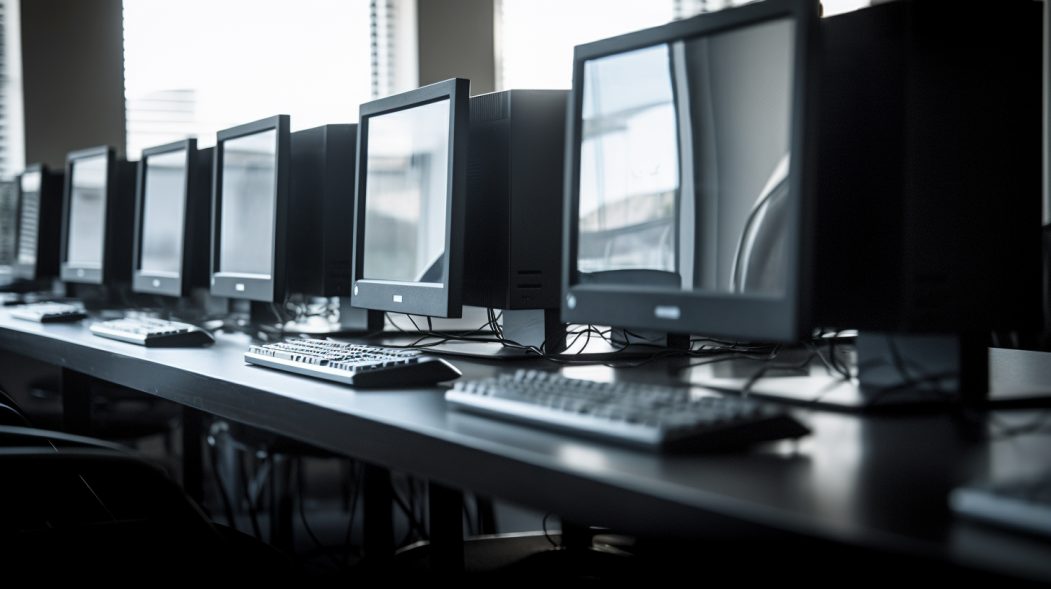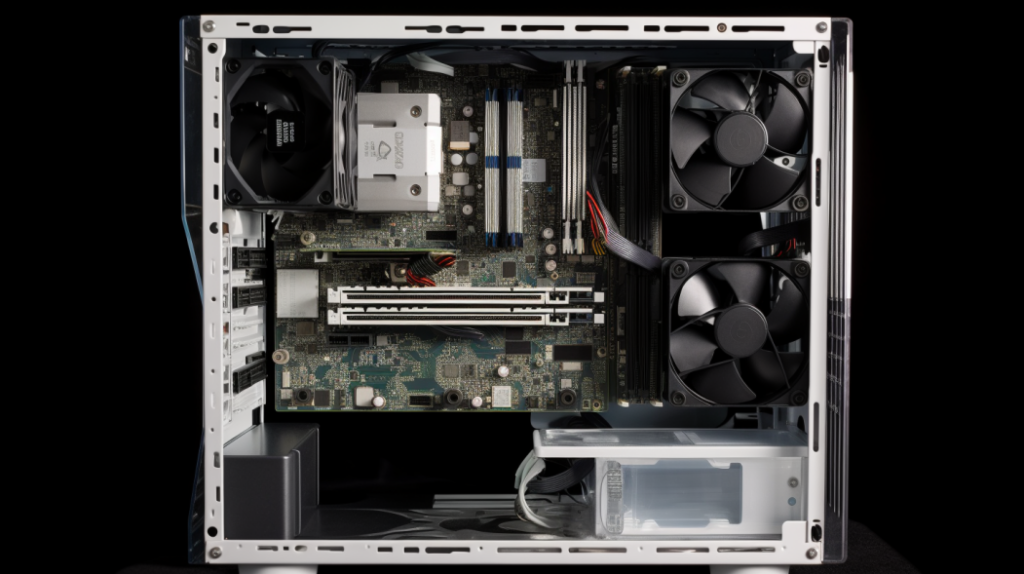What is a Desktop Computer?
Having worked with various computing devices over the years, I can attest that a desktop computer stands out as a robust and dedicated machine, specifically tailored for consistent use in a fixed setting.
Often compared to laptop computers, a desktop computer consists of separate components such as a display screen, keyboard, mouse, and a central processing unit (CPU), which houses the essential hardware and software components that drive the system.

This article provides an overview of desktop computers, their components, advantages, and some of the main aspects to consider when buying one, especially in the consumer market.
So, without further ado, let’s get into it!
Components of a Desktop Computer
From our years of assembling and tweaking desktops, I’ve come to appreciate how each component of a full-sized desktop plays a crucial role, harmoniously working together to deliver an unparalleled computing experience.
These components include:
Central Processing Unit (CPU)
The CPU, also known as the ‘brain’ of the computer, is responsible for executing instructions and processing data.

It comprises the following parts:
Processor: The processor carries out instructions and performs calculations at incredible speeds. Modern processors are increasingly popular for their multitasking capabilities.
Motherboard: The motherboard is the main circuit board that connects all the components of the computer and allows them to communicate with each other.
Memory (RAM): Random Access Memory (RAM) is a temporary storage that holds data and instructions that the processor needs to execute tasks.
Storage: This includes hard drives that store the operating system, applications, and user data. With the advent of SSDs, accessing files has become faster than traditional hard drives.
Monitor
Over the years, we’ve had the privilege of testing various monitors. The size and resolution indeed play a pivotal role in the visual experience.
We’ve noticed that while LCDs are energy savers, their viewing angles can be restrictive. LEDs, on the other hand, offer a stark contrast with a sleek design. And if you’re looking for top-notch color accuracy, OLEDs are the way to go, though they do have a tendency for burn-in if not handled correctly.
Consider refresh rate for smooth motion display and connectivity options like HDMI, DisplayPort, and USB-C for device compatibility.
Keyboard and Mouse
Having typed on a myriad of keyboards, we’ve developed a keen sense for their nuances. Mechanical keyboards, with their tactile feedback, are a joy for long typing sessions. Membrane keyboards, while quieter, offer an affordable alternative. And for those who, like us, despise cable clutter, wireless keyboards are a godsend.
Mice options include optical mice (accurate and reliable), laser mice (greater accuracy on smooth surfaces), wireless mice (clutter-free workspace), and gaming mice (customizable buttons and sensitivity).
Peripheral Devices
Peripheral devices enhance desktop computer functionality by offering additional features and capabilities. Common peripherals include:
Printers: Convert digital documents and images into hard copies, with options like inkjet (high-quality color prints) and laser (fast and efficient black-and-white prints).
Scanners: Digitize physical documents and images for easy storage and sharing, with flatbed (versatile for various document types) and sheet-fed (compact and fast) scanners available.
Speakers and headphones: Improve audio output for music, videos, and other content. Speakers provide room-filling sound, while headphones offer personal listening and noise isolation.
Advantages of Desktop Computers
From personal experience, while laptops and tablets have their merits, desktop computers bring a unique set of advantages to the table that often outweigh their portable counterparts.
Some of these advantages include:
Customization: Desktop computers can be easily customized with different components to suit individual needs and preferences.
Upgradeability: Users can upgrade specific components, such as the processor, RAM, or storage, to improve performance, get more space, or extend the life of their all-in-one computers.
Better performance: Desktop PCs often have more powerful hardware, providing faster processing speeds and better overall performance.
Lower cost: Desktop computers, especially a virtual machine, usually have a lower initial cost compared to laptops with similar specifications.
Better ergonomics: Desktop computers offer a more comfortable and ergonomic setup with a separate monitor, keyboard, and mouse.
Factors to Consider When Buying a Desktop Computer
When purchasing a desktop computer, often referred to as a personal computer or simply a “computer,” there are several factors to consider to ensure you get the best system for your needs:
Purpose
Determine the primary purpose of the desktop PC, sometimes referred to as a “desktop” or “desktop pcs.” Some common uses include:
Office work: A basic desktop computer with a decent processor and sufficient RAM is ideal for tasks such as word processing, web browsing the internet, and managing emails. This is where most users access the internet and do their web browsing.
Gaming: Gaming computers, which are a subset of personal computers, require powerful processors, high-end graphics cards, and ample RAM to run resource-intensive games smoothly.
Multimedia creation: Desktop computers for multimedia tasks, such as video editing, graphic design, computer lab, or music production, need powerful processors, plenty of RAM, and high-performance storage. These are not your typical all-in-one computers but are more specialized.
Operating System
The operating system (OS) is the software that manages the computer’s hardware and software resources. Some popular systems include:
Microsoft Windows: A widely-used OS compatible with a vast array of software and hardware. Windows is a dominant player in the consumer market.
macOS: Apple’s proprietary OS designed specifically for Mac computers, known for its user-friendly interface and seamless integration with other Apple devices.
Linux: An open-source OS that offers more control and customization options, often preferred by developers and advanced users.
Hardware Specifications
When selecting a desktop computer, it’s crucial to consider its hardware specifications. These specifications determine the computer’s performance, capabilities, and overall user experience. Let’s delve deeper into some of the primary hardware components:
Processor
The processor, often referred to as the CPU (Central Processing Unit), is the heart of any computer. It’s responsible for executing instructions and processing data, making it a critical component in determining the overall performance of your desktop computer. When choosing a processor, consider the following:
Number of Cores: Modern processors come with multiple cores, allowing them to handle several tasks simultaneously. More cores generally mean better multitasking capabilities.
Clock Speed: Measured in gigahertz (GHz), the clock speed determines how quickly the processor can execute instructions. A higher clock speed usually translates to faster performance.
Cache Size: Cache is a small amount of high-speed memory located on the processor. It stores frequently used data and instructions, speeding up the processing time. A larger cache can significantly improve performance, especially for data-intensive tasks.
RAM (Random Access Memory)
RAM is the computer’s short-term memory. It temporarily stores data that the processor may need to access quickly. The amount of RAM a desktop computer has can significantly impact its performance:
Capacity: More RAM allows the computer to handle more tasks simultaneously without slowing down. A minimum of 8GB is recommended for most users. However, for gaming, video editing, or other multimedia tasks, 16GB, 32GB, or even more might be necessary.
Speed: RAM speed, measured in megahertz (MHz), determines how fast data can be read or written. Faster RAM can boost the computer’s overall speed, especially in data-intensive applications.
Storage
Storage is where the computer keeps its data, including the operating system, applications, and user files. When considering storage options, keep the following in mind:
Type: There are two main types of storage devices: Hard Disk Drives (HDD) and Solid State Drives (SSD). HDDs are traditional spinning disks and are generally cheaper but slower. SSDs, on the other hand, have no moving parts and offer faster performance, but they are typically more expensive.
Capacity: Depending on your needs, you might require more or less storage. For basic tasks, a 256GB or 512GB SSD might suffice. However, for users with extensive media libraries or those who work with large files, 1TB or more might be necessary.
Graphics
The graphics component determines how the computer renders images and videos. It’s especially crucial for tasks like gaming, video editing, and 3D modeling:
Integrated vs. Dedicated: Integrated graphics use the computer’s RAM and are built into the processor. They are suitable for basic tasks like web browsing and document editing. Dedicated graphics cards, on the other hand, come with their own RAM and are separate components. They are necessary for gaming, multimedia work, and other graphics-intensive tasks.
Memory: Graphics cards come with their own memory, known as VRAM (Video RAM). More VRAM allows the card to handle higher resolutions and more complex graphics.
Form Factor
Desktop computers come in various form factors, such as:
Customization: Desktop computers can be easily customized with different components to suit individual needs and preferences.
Upgradeability: Users can upgrade specific components, such as the processor, RAM, or storage, to improve performance, get more space, or extend the life of their all-in-one computers.
Better performance: Desktop PCs often have more powerful hardware, providing faster processing speeds and better overall performance.
Lower cost: Desktop computers, especially a virtual machine, usually have a lower initial cost compared to laptop computers with similar specifications.
Better ergonomics: Desktop personal computers offer a more comfortable and ergonomic setup with a separate monitor, keyboard, and mouse.
Budget
Consider your budget when selecting a personal computer. You can find a wide range of options at different price points, from budget-friendly systems for basic tasks to high-end machines for gaming and multimedia work.
Conclusion
A desktop computer is a versatile and customizable computing device designed for use at a single location.
With a wide range of components and configurations available, users can tailor their desktop systems to suit their specific needs and preferences.
When purchasing a desktop computer, it is essential to consider factors such as the intended purpose, OS, hardware specifications, form factor, and budget to ensure you get the best system for your needs.



